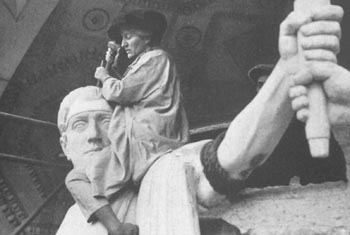![[MetroActive Features]](/gifs/feat468.gif)
[ Features Index | Metro Santa Cruz | MetroActive Central | Archives ]
Refuse to Be Typecast
America's Rodin: American sculptor Malvina Hoffman studied with Rodin in Paris but has been largely ignored by the art establishment in her own country.
Malvina Hoffman
SHE IS AMERICA'S RODIN, a sculptor of towering talent who studied with the French master between 1910 and his death seven years later. She worked with various materials, but her monumental bronzes, most of which are in Chicago's Field Museum, constitute one of the most impressive bodies of work by any American artist of any era--and of either sex.
She is, in short, the greatest American artist you've never heard of. No book-length biography of her has been written.
Malvina Hoffman was born in New York City to artistic parents who encouraged her talent. At the age of 24 she produced her first sculpture: a portrait of her pianist father.
"My child," he said affectionately upon viewing the work, "I'm afraid you are going to be an artist." He passed away two weeks later. The following year, Hoffman and her mother moved to Paris. In her book Heads and Tales, Hoffman tells how she was turned away five times from trying to meet Rodin. But she refused to take no for an answer.
"Tell Monsieur Rodin," she said to the concierge at his Paris studio, "that if he does not see me today I must return to America, but I came to Paris to study with him. ... I shall not leave, he must admit me today."
Rodin saw her and recognized her talent immediately. By 1915, Hoffman had achieved some fame of her own. She went on to become a master founder in order to cast her own bronzes, even when most male sculptors left the heavy lifting to foundry workers. She later published a technical book on bronze casting, Sculpture: Inside and Out.
She approached her task with a commitment to capturing the individual spirit of each subject.
"To understand the submerged passion that burns in the human eye, to read the hieroglyphs of suffering etched in the lines of a human face ... to watch the gesture of a hand or listen for the false notes and the true in a human voice," she wrote in Heads and Tales, "these were the mysteries that I found I must delve into and try to unravel when I made a portrait."
Her greatest opportunity came in 1930, when the board of directors of the Field Museum commissioned her to travel around the world to produce a series of sculptures to be called the Races of Man. It took five years, and in the end Hoffman had produced 35 full figures, one half figure, 30 busts and 39 heads. The results were stunning--and controversial.
Her work was criticized by social scientists as too reliant on physical over cultural characteristics. The prevailing abstract artists of the day saw her work as either too realistic or too romantic. By the time of her death in 1966, figures such as her Nordic Type or Bushman Man were dismissed as anthropologically incorrect, and her work was mothballed.
Gradually, in the years since, critics and the museum itself have taken a different view, seeing in Hoffman's work not a simplification of ethnic types but extraordinary recreations of vibrant individuals from different cultures. The figures reveal more than mere technical prowess and anatomical detail; they seem ready at any moment to spring forth. Hoffman's subjects, frozen in a moment of time, in joyous motion or deepest concentration, exude life.
So, say those who knew her, did she.
[ Santa Cruz | MetroActive Central | Archives ]
Copyright © Metro Publishing Inc. Maintained by Boulevards New Media.
![]()

From 'Heads and Tales'
Sculptor
1885-1966
--John Yewell
From the March 10-17, 1999 issue of Metro Santa Cruz.